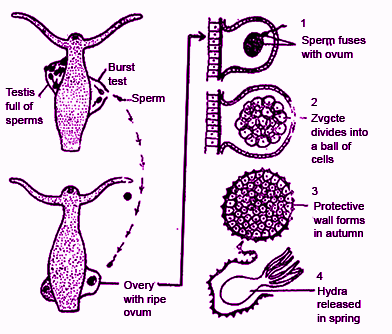
Answer
444.9k+ views
Hint: Hydra is a small, multicellular freshwater eukaryotic organism that usually reproduces asexually by budding (a process by which a small part of the adult structure becomes new). But sexual reproduction occurs in some Hydra. Swelling in the body wall develops either into ovaries or testis. Cross-fertilization occurs in Hydra.
Complete answer: Cross fertilization occurs in Hydra. In Hydra, the testis matures earlier than the ovary. Testis releases mature sperm cells that swim in the water with the help of tail and through water, it reaches to the second Hydra. One of the sperm comes into contact with the ovum and fertilised female egg develops into a zygote. The body of the Hydra looks like a tube with tentacles arranged around the head pole of the organism. The reproductive structures of hydra consist of the testis (produce sperm cells) and the ovary (produces the egg) that are located under the ectoderm. The testis is formed near the oral end of the hydra while the ovaries formed near the basal end. Only one spermatozoon fuse with the ovum completely and fertilises it. The process of fertilization takes place effectively only when the sperm reaches the ovum within its viable condition. It remains for two hours from its being exposed to naked otherwise it perishes. Moreover, the fertilized egg undergoes a number of steps such as cleavage, blastulation, gastrulation, encystation and hatching.
Therefore, option D is the correct answer.
Note: Some of the Hydra has both male and female reproductive organs and are known as hermaphrodites. Hydra has a tubular, radially symmetric body that extends up to 10 mm long, secured by a simple adhesive foot called the basal disc. A sticky fluid is secreted by gland cells present in the basal disc that accounts for its adhesive properties.
Complete answer: Cross fertilization occurs in Hydra. In Hydra, the testis matures earlier than the ovary. Testis releases mature sperm cells that swim in the water with the help of tail and through water, it reaches to the second Hydra. One of the sperm comes into contact with the ovum and fertilised female egg develops into a zygote. The body of the Hydra looks like a tube with tentacles arranged around the head pole of the organism. The reproductive structures of hydra consist of the testis (produce sperm cells) and the ovary (produces the egg) that are located under the ectoderm. The testis is formed near the oral end of the hydra while the ovaries formed near the basal end. Only one spermatozoon fuse with the ovum completely and fertilises it. The process of fertilization takes place effectively only when the sperm reaches the ovum within its viable condition. It remains for two hours from its being exposed to naked otherwise it perishes. Moreover, the fertilized egg undergoes a number of steps such as cleavage, blastulation, gastrulation, encystation and hatching.
Therefore, option D is the correct answer.
Note: Some of the Hydra has both male and female reproductive organs and are known as hermaphrodites. Hydra has a tubular, radially symmetric body that extends up to 10 mm long, secured by a simple adhesive foot called the basal disc. A sticky fluid is secreted by gland cells present in the basal disc that accounts for its adhesive properties.
Recently Updated Pages
10 Examples of Evaporation in Daily Life with Explanations

10 Examples of Diffusion in Everyday Life

1 g of dry green algae absorb 47 times 10 3 moles of class 11 chemistry CBSE

What is the meaning of celestial class 10 social science CBSE

What causes groundwater depletion How can it be re class 10 chemistry CBSE

Under which different types can the following changes class 10 physics CBSE

Trending doubts
Fill the blanks with the suitable prepositions 1 The class 9 english CBSE

Which are the Top 10 Largest Countries of the World?

How do you graph the function fx 4x class 9 maths CBSE

Who was the leader of the Bolshevik Party A Leon Trotsky class 9 social science CBSE

The Equation xxx + 2 is Satisfied when x is Equal to Class 10 Maths

Differentiate between homogeneous and heterogeneous class 12 chemistry CBSE

Difference between Prokaryotic cell and Eukaryotic class 11 biology CBSE

Which is the largest saltwater lake in India A Chilika class 8 social science CBSE

Ghatikas during the period of Satavahanas were aHospitals class 6 social science CBSE





